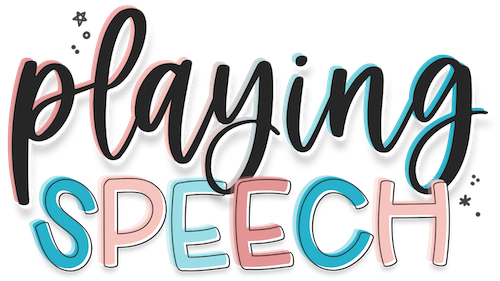The Ultimate Guide to Speech Intelligibility in Toddlers
How much of a toddler’s speech should I be able to understand?
That’s a loaded question! There are so many variables to consider when looking at intelligibility in toddlers.
Some factors that impact intelligibility:
Do you know this toddler well?
Are you familiar with their speech patterns?
Is the context of what they are talking about known? (e.g. Do you know they are talking about Paw Patrol?)
Do you have a general knowledge of the topic they are talking about so that you can fill in any gaps due to unintelligible speech? (e.g. You know they are talking about Paw Patrol and are familiar with the names of the characters.)
Considering these variables, there are 3 research studies on the topic of intelligibility that we can use to get a picture of overall intelligibility in toddlers’ speech.
The research about toddler’s speech intelligibility
There are 3 studies that specifically look at speech intelligibility in toddlers. Let’s take a closer look at them:
Lynch et al., 1980 – In this study, parents reported how much THEY were able to understand their toddlers with known context. This study reports that children were estimated to be 25% intelligible by 18 months; 50-75% intelligible by age 2; and 75-100% intelligible by age 3.
Coplan & Gleason, 1998 – In this study, parents reported how much they thought an unfamiliar listener should be able to understand their toddler. This study stated that a child is estimated to be 50% intelligible by age 2; 75% by age 3; and 100% by age 4. These are the norms most of us were taught in grad school.
Hustad et al., 2021 – This most recent study judged intelligibility using unfamiliar listeners who had zero context for what the child was saying. The listeners in the study assessed intelligibility based on audio recordings of children speaking. This meant that (in addition to having zero familiarity or context) they could not use visual cues for support. The study reported ranges of speech intelligibility in sentences based on what 90% and 50% of children can do at a given age. They concluded that a child should be 12-41% intelligible by age 3, 41-69% at age 4, and 66-85% by age five. It’s likely that these results underestimate functional intelligibility due to the methods of data collection (e.g. unknown listeners, no context, audio recordings).
If all that data is confusing to you, you’re not alone! We have 3 different studies here with 3 different methods of data collection and contexts for reporting on speech intelligibility in toddlers. All of these studies have a place and offer data on what’s expected by age in different environments and contexts. Ultimately, we need to focus on the functional impact of a speech sound disorder when making decisions about intervention.
So should we work on speech intelligibility with toddlers?
The short answer is yes! We know that speech sound errors and decreased intelligibility impact functional communication skills. Parents and SLPs report that unintelligible young children have difficulty participating in many everyday activities. We also know that early intervention has shown positive outcomes for toddler speech sound production and improved speech sound inventory for both consonants and vowels.
With all that considered, how do we move forward when we think a toddler needs some help with speech intelligibility?
What speech therapy interventions are available for children under 4?
The Stimulability Approach
The Cycles Approach and/or Focused Auditory Input
A Core Vocabulary Approach
A Motor-Based Intervention (e.g. PROMPT or DTTC).
A comprehensive assessment will help you determine what approach is optimal for each child. Beyond picking an intervention approach, there is so much that goes into effective speech sound therapy with toddlers. We need to pick functional targets, embed them into play-based therapy, keep them engaged, utilize multisensory cueing to support proper productions, and make it all look easy and fun!
Want to learn more about speech sound disorders in toddlers?
If you’re ready to learn more, consider joining us in the course: Speech Sound Disorders in Early Intervention. We will cover everything you need to know about the identification, assessment, and treatment of speech sound disorders in children ages 2-4.
Click HERE to join the course!
We would love to have you join our community of over 500 SLPs that have already taken the course!
SOURCES:
Lynch, J.I., Brookshire, B.L., and Fox, D.R. (1980) A Parent-Child Cleft Palate Curriculum: Developing Speech and Languaga. CC Publications, Oregon. Page 102
Hustad, K. C., Mahr, T., Natzke, P. E. M., & Rathouz, P. J. (2020). Development of Speech Intelligibility Between 30 and 47 Months in Typically Developing Children: A Cross-Sectional Study of Growth. Journal of speech, language, and hearing research : JSLHR, 63(6), 1675–1687. https://doi.org/10.1044/2020_JSLHR-20-00008
Coplan, J., & Gleason, J. R. (1988). Unclear speech: recognition and significance of unintelligible speech in preschool children. Pediatrics, 82(3 Pt 2), 447–452.




